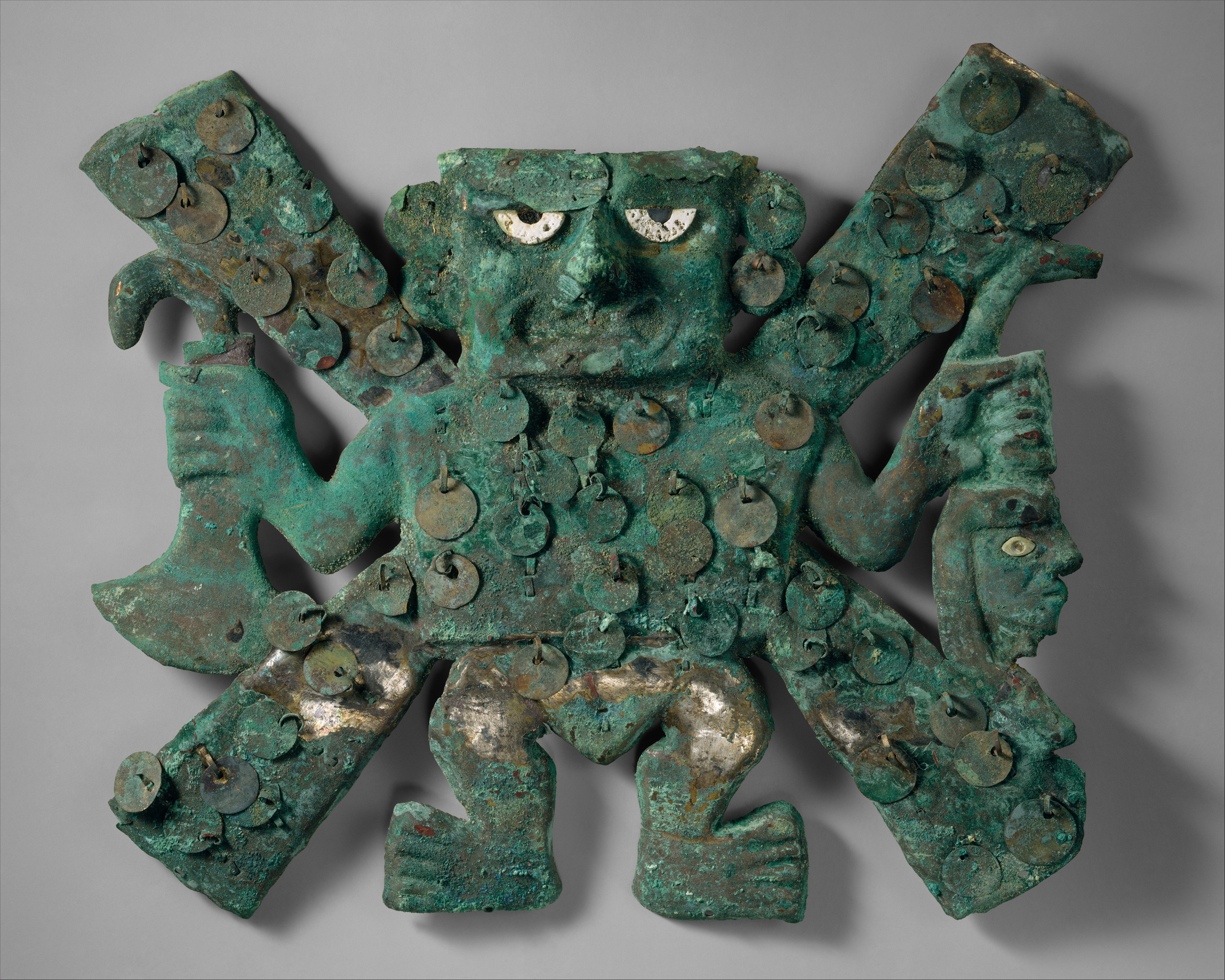Decapitator plaque
Not on view
This menacing figure is known by scholars of Moche art as the Decapitator or sometimes Ayapec (also spelled Ai Apaec) because he is often depicted holding a trophy head in one hand and a tumi—a knife with a crescent-shaped blade—in the other. The figure was worked from a sheet of silvered copper that was then embellished with inlays and attachments. The figure wears a tunic and loin cloth, and his eyes, and those of the trophy head, were inlaid with shell; the mouth was originally inlaid with shell teeth. The ears are represented by two circles forming a figure-eight-like design. Four ray-like elements extend diagonally outward behind the figure. Remnants of what was probably a headdress ornament remain on the figure’s forehead. The rays, tunic, ears, and headdress were covered by round gilded dangles affixed by thin wires.
Scholars have noted that on other depictions of figures with diagonal projections there is often a line bisecting the ray, thus creating eight extensions, evoking the eight legs of a spider (Alva, 2008; Cordy-Collins, 1992; see also MMA 1979.206.1247). The original function of this object is unknown; the small holes at the end of each ray, the head, and the feet, however, suggest that it was once sewn onto a banner or shield frontal (see, for example, MMA 1982.392.8).
The significance of the association of this powerful figure with spiders is unclear, but perhaps the way spiders trap their prey in a web and liquefy their internal organs was considered analogous to the Moche practice of prisoner capture and sacrifice by bloodletting (Alva, 2008; Cordy-Collins, 1992). Alternatively, spiders capture dew in their webs in the wet season, and the imagery may be related to water and seasonal change (Alva, 2008). Alva has argued, based upon physical attributes as well as web shape, that the spider represented is Argiope argentata, which is common on the Peruvian coast.
The Moche (also known as the Mochica) flourished on Peru’s North Coast from 200-850 CE, centuries before the rise of the Inca. Over the course of some seven centuries, the Moche built thriving regional centers from the Nepeña River Valley in the south to as far north as the Piura River, near the modern border with Ecuador, developing coastal deserts into rich farmlands and drawing upon the abundant maritime resources of the Pacific Ocean’s Humboldt Current. Although the precise nature of Moche political organization is unknown, these centers shared unifying cultural traits such as religious practices (Donnan, 2010).
This ornament was said to have been found at a site or sites known as Loma Negra, a northern outpost of Moche culture. Loma Negra works in metal share similar iconography with ceramics and metalwork found at Moche sites father to the south, such as Ucupe (Bourget, 2014). The exact relationship between Loma Negra and the Moche “heartland” remains a subject of debate, however (Kaulicke, 2006).
References and Further Reading
Alva Meneses, Néstor Ignacio. “Spiders and Spider Decapitations in Moche Iconography: Identification from the Contexts of Sipán, Antecedents and Symbolism.” In The Art and Archeology of the Moche, edited by Steve Bourget and Kimberly L. Jones, pp. 247-261. Austin: University of Texas Press, 2008.
Bourget, Steve. Les rois mochica: Divinité et pouvoir dans le Pérou ancien. Paris: Somogy éditions d'art. Geneva: MEG, Musée d'ethnographie de Genève, 2014.
Castillo, Luis Jaime. “Masters of the Universe: Moche Artists and Their Patrons.” In Golden Kingdoms: Luxury Arts in the Ancient Americas, edited by Joanne Pillsbury, Timothy Potts, and Kim N. Richter, pp. 24-31. Los Angeles: J. Paul Getty Museum, 2017.
Cordy-Collins, Alana. “Archaism or Tradition? The Decapitation theme in Cupisnique and Early Moche Iconography.” Latin American Antiquity 3, (1992), pp. 207-219.
Donnan, Christopher B. “Moche State Religion.” In New Perspectives on Moche Political Organization, edited by Jeffrey Quilter and Luis Jaime Castillo, pp. 47-69. Washington D.C.: Dumbarton Oaks Research Library and Collection, 2010.
Kaulicke, Peter. “The Vicús-Mochica Relationship.” In Andean Archaeology III, edited by William H. Isbell and Helene H. Silverman, pp. 85-111. Boston: Springer, 2006.
This image cannot be enlarged, viewed at full screen, or downloaded.
This artwork is meant to be viewed from right to left. Scroll left to view more.



